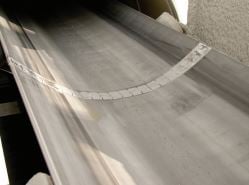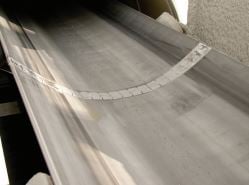By Lee Mueller on Jul 24, 2020 3:25:32 PM
If you have been in the bulk materials business for longer than a week, you have probably been involved in some form of conveyor belt splice repair. Other than a scheduled belt replacement, the common need for splicing is due to some form of damage to the belt. The types of belt damage may range from punctures due to the impact from large lumps of product to rips and tears due to the belt mistracking into the conveyor structure or components. Whatever the cause of the damage, some form of urgent repair is needed.
There are many types of repairs available for use in the conveyor belting industry. They range from vulcanized to mechanical to flexible matrix plate splices. The type of splice chosen is often the type that can be installed the quickest so as to bring the plant back on line. It is also common to deviate from good splice installation practices when installing these urgent repairs. This deviation will most likely result in maintenance staff being instructed to “back off the cleaners.”
The action of backing off the belt cleaners is now going to result in an increased amount of carryback along that specific section of the plant, resulting in decreased productivity and increased clean up requirements.
Most often, urgent repairs are made with mechanical clips of some type. Some are hinged and some are solid flats. Mechanical splices can easily be installed by plant personnel; however, as a consequence, they can easily be misapplied by untrained personnel or in the all-too-common “get it running” situation. It is very common to see these types of repairs made without “skiving” both sides of the belt's splicing area. Skiving is the act of removing enough surface rubber in the splicing area to ensure the top of the mechanical clips are at or below the carrying surface of the belt. Additionally, the leading edges of the clips should be dressed with a grinder to help the splice negotiate its way past the leading edge of the belt cleaner. Notching the trailing splices' outside corners should also be a habit. The notch should be cut from the first fastener on each end of the splice out to the edge of the belt at a 60° angle. This will help prevent the trailing edge from catching on the conveyor structure and damaging the splice or tearing the belt.

The end result of a properly-installed splice means the conveyor cleaners DO NOT have to be backed off when the belt is put back into operation.



comments